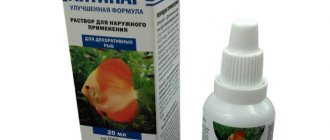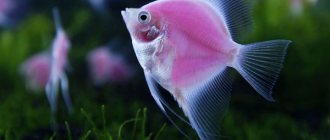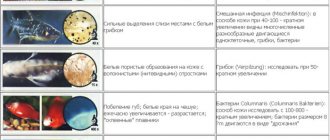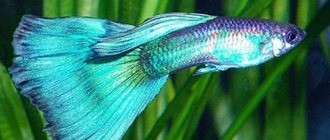All owners of aquarium fish want their bright and colorful pets to always remain vigorous, healthy and delight them with their beauty and grace for a long time. However, fish, like other living creatures, are susceptible to various kinds of ailments, of which infectious diseases are considered the most dangerous. Malachite green is a universal medicine for the aquarium, designed to combat illnesses of bacterial or infectious origin, the action and effectiveness of which has been tested by many aquarists in practice. However, like all medicines, malachite green requires careful and attentive treatment. Before using this miraculous conditioner for aquarium water, you should find out the composition of malachite green and the permissible concentration of the drug.
What problems does the drug solve?
Malachite green is used for almost all types of fish. Copes with a lot of problems. Which should include:
- fin rot and ringworm. Diseases manifest themselves as damage to the fins and skin of fish. In the first stages, treatment is successful. In severe cases, many aquatic inhabitants die. The causes of the disease are improper living conditions and bacterial infections brought from the environment;
- to combat certain protozoan parasites;
- trichodinosis - the causes of the disease are parasites that accumulate in the gills and on the skin. The body of the fish becomes covered with gray spots, the fish refuses food;
- semolina - the body of the fish is covered with bubbles. The fish spends most of its time in the ground area, rubbing its body against the coating and decorations.
To treat an aquarium with fish, the instructions must be followed. Excessive amounts of malachite green solution may harm aquatic life.
special instructions
The instructions for use of malachite green indicate that this drug can only be used for the treatment and treatment of mature individuals. Also, procedures with this conditioner are only possible for the following types of fish.
- Barbs.
- Veiltails.
- Guppy.
- Gourami.
- Sword bearers.
- Mollies.
- Nannostomus arapirangii.
- Pecilia.
- Playfairy.
- Rasboras are heteromorphs.
- Shubunkins.
Rules of application
Malachite green can be used both in an aquarium and in a special bath. The method depends on the size of the container and the problem that needs to be solved. In order for the use of the conditioner to give a positive result, it is important to follow the following rules:
- Aquarium water conditioner is diluted in a small flask before adding to the general container. To do this, use 250 ml of clean water, to which you should add 5 ml of the substance and 5 drops of copper sulfate per 10 liters of aquarium water. The resulting solution is stirred until the color of the liquid is uniform;
- The water temperature in aquariums is increased to 28 degrees. This method allows you to achieve the desired result in treatment;
- the resulting solution is divided into 3 equal portions;
- in the vessels where fish are kept during the treatment period, all filters are removed. The solution is carefully poured in. After each dose, the water in the container is thoroughly mixed.
Between each procedure of using the malachite green solution, at least a week should pass. The duration of use of the drug is no more than 1 month, after which it is recommended to take a break.
In cases where during treatment it is necessary to supplement the liquid in the aquarium, the concentration of the drug must be observed. Otherwise, the desired result will not be achieved.
To use malachite green substance for the bath, use a proportion of 1 ml per 10 grams of water. The fish is placed in a container for 40-45 minutes. The number of procedures is at least 5 times a day.
In a quarantine container
A quarantine aquarium is an aquarium where fish are placed for a certain period of time. These are sick individuals who undergo treatment for 4 days. The duration of the procedure is about 5 hours daily. In the first 2 days, they prepare the medicinal composition:
- Pour 2 liters of water into a container.
- Dissolve 5 ml of malachite green in liquid.
The dosage is gradually increased for 3-4 days. Traditional 5 ml is poured into 1.5 liters of water. Fresh solution must be prepared daily.
In the quarantine container, the temperature of the liquid should be maintained at +25 degrees. Continuous aeration of the water should also be ensured.
Possible contraindications
All medications should be used with caution. It is necessary to highlight possible side effects from this type of treatment:
- not used for fry, and in containers containing caviar;
- do not use the solution with other medications;
- If the fish begin to behave restlessly after adding the solution, it is recommended to add clean water to the aquarium.
The malachite preparation contains a dye that turns the water green. The color of the water can last for several days.
Description of the medicine
In its pure form, malachite green is a crystalline substance of greenish or yellow color with a metallic sheen. Easily dissolves in water. You can purchase conditioner with or without zinc. A widely used medicine produced by “Zoomir” is a convenient package equipped with a measuring cap that holds 5 ml of the drug.
Composition and release form
Conditioner "Zoomir" is available in 50 ml volumes. The composition contains 10 mg of malachite green. A full bottle of conditioner can be used to treat a 100-liter aquarium.
Useful tips
In order for the aquarium medicine to help get rid of problems, it is important to follow the simple recommendations of professionals:
- measure the amount of solution using a special measuring cup;
- When using a substance in powder, you must first stir it in water;
- during the treatment period, it is recommended to feed aquatic inhabitants only with live food;
- It is recommended to place infected fish in a separate container. Use individual items to care for fish.
Use only a specialized solution for aquariums. You can purchase such a product at almost any zoological store.
Precautionary measures
The drug should be used exclusively for its intended purpose, strictly following the instructions. As soon as the need for use disappears, you need to put it in a cool, dark place , away from food products. This area should also be inaccessible to children and pets.
To treat the fish, place them in a separate aquarium with a medicinal solution.
While working with the composition, you should not eat or smoke. When using malachite green, the instructions should be strictly followed. If the medication gets on your skin, rinse it thoroughly with water.
Aquarium water conditioner retains all its characteristic properties after freezing and thawing. If stored at low temperatures, sediment may form. To dissolve it, before use, warm the product to room temperature and shake well.
DIY recipe
You can purchase the ingredients for FMC yourself at the pharmacy and prepare a solution.
Add 1.75 g of malachite green and 1.75 g of methylene blue in the form of crystals or 175 ml of a 1% solution to 0.5 liters of formaldehyde.
Introduction
In Bangladesh, a large number of fish die every year in various fish farms due to outbreaks of bacterial and fungal diseases. The main bacterial diseases in Bangladesh are aeromonosis, bacterial hemorrhagic septicemia, Edwardsiella infestation and columnar disease (branchiomycosis and fin rot), which are caused by mobile Aeromonas sp., fluorescent pseudomonas (Pseudomonas fluorescens), Edwardsiella sp. Flavobacterium, respectively. As preventive and control measures to stop diseases, fish farmers and fish factory owners use various types of disinfectants. Copper sulfate (CuSO4), potassium permanganate (KMnO4), methylene blue and malachite green are known chemicals used to kill external parasites and fungal diseases in fish. Copper sulfate (CuSO4) is an effective algaecide, but it is toxic to many fish species.
Factors influencing copper toxicity are related to water quality characteristics such as hardness, alkalinity, hardness, and dissolved organic carbon. Increasing these water quality parameters results in a reduction in copper toxicity and a subsequent increase in the acceptable dose for fish, while higher concentrations are required to control algae growth.
Potassium permanganate (KMnO4) is toxic to bacteria and phytoplankton and is commonly used to neutralize fish toxins such as tubotoxin and antimycin. The use of methylene blue against bacterial, fungal and parasitic infections has shown that it is effective against superficial fungal infections in fish. In addition, it kills plants and biofilter bacteria in the aquarium. The medicine can be used as an alternative to malachite green to control fungal growth if treatment with the latter substance is not possible due to intolerance in fish. Methylene blue is safe for fish eggs and fry, so it is used to prevent fungal infections. The substance can be used repeatedly to kill external protozoa such as Ichthyophthirius, Chilodonella and Costia. Methylene blue was effective in reducing bacterial loads in juvenile Nile tilapia (Orechromis niloticus). Malachite green has been frequently used in the control of external protozoan infections and fungal diseases since 1993, but due to its negative effects on fish and aquatic life, the substance has not yet been listed as a veterinary drug. However, in Bangladesh, fishermen do not know the proper doses of disinfectants and often use disinfectants in too high doses, which can lead to toxicity and even death of the fish. Unfortunately, no systematic research has yet been conducted to address these issues.
Considering the facts, this study was conducted to determine the toxic effects of four disinfectants namely copper sulfate (CuSO4), potassium permanganate (KMnO4), methylene blue and malachite green on fish and pathogenic bacteria: Aeromonas spp., Pseudomonas fluorescens, Edwardsiella spp. and Flavobacterium spp.
Products for thyroid disease
To reduce the risk of pathologies of the endocrine system, doctors recommend dietary nutrition with substances important for thyroid health. To prevent diseases and treat the organ, it is necessary to include in the diet the following foods:
- Feijoa and persimmon - these iodine-containing fruits can be eaten at any time of the year. Fruits are also rich in sodium, magnesium and iron. In addition, persimmon and feijoa are a storehouse of vitamin compounds A, C and P.
- Fresh seafood - mussels, crabs, fish, lobsters, shrimp, squid, etc. The same iodine-rich foods as persimmon and feijoa. Contains zinc, fatty acids, phosphorus, protein, B12. People who love seafood have strong immunity; their endocrine system is regularly fed with important hormones.
- Sea kale is the primary source of iodine compounds. What kind of prevention of endocrine diseases will be possible without this ingredient? It is enough to eat 70-100 grams of seaweed per day for the body to consistently produce thyroid hormones. Also contains phosphorus, magnesium, silicon and a number of other useful minerals.
- Red fish - salmon, trout, pink salmon, salmon and any red meat contain tyrosine. This substance helps synthesize necessary hormones. If there is enough red fish in the diet, then the body receives calcium, omega-3 fatty acids, vitamin D, and phosphorus. In addition, fish liver is a source of selenium.
- Spinach and onions strengthen the immune system and are also natural antioxidants. In addition, spinach contains a unique set of microelements important for the health of the endocrine system. These are phosphorus, zinc, iodine compounds, sodium, manganese and others.
It is also necessary to note the benefits of apples, berries and nuts for all body systems. Pine nuts and walnuts are rich in iodine compounds. Apples and blueberries contain antioxidant substances that protect cells from the harmful effects of free radicals.
Results and discussion
Aquaculture is an important economic sector in Bangladesh. However, the spread of various diseases, including bacterial infections, limits fish production in fish farms. Various disinfectants are traditionally used to prevent and control fish diseases. However, these disinfectants are toxic and can even kill fish. The present study found lethal concentrations of copper sulfate (CuSO4), potassium permanganate (KMnO4), methylene blue and malachite green for rohu fry: 0.75 mg/l, 7.00 mg/l, 6.00 mg/l and 0 .50 mg/l for 21.4 hours, 18.0 hours, 9.5 hours and 1.4 hours, respectively. Bills (1974) reported an LC50 value of 2 mg/L for malachite green for juvenile rainbow trout.
Bactericidal effect of copper sulfate (CuSO4), potassium permanganate (KMnO4), methylene blue and malachite green
The inhibitory effects of four disinfectants on four main pathogenic bacteria in fish were analyzed under artificial conditions. Experimental data indicate that the bacteria Pseudomonas fluorescens and Aeromonas were unable to reproduce at methylene blue concentrations of 4 mg/L or 5 mg/L and 6 mg/L, respectively. The growth of Edwardsiella stopped in CuSO4 solution with concentrations of 10 mg/l and 8 mg/l. Flavobacterium was found to be resistant to copper sulfate (CuSO4), potassium permanganate (KMnO4) and methylene blue at all concentrations, but sensitive to malachite green at a concentration of 1 mg/l. Potassium permanganate (KMnO4) failed to stop the growth of any of the four bacterial species at all concentrations tested, while malachite green inhibited the growth of all bacteria at a concentration of 1 mg/L. Only methylene blue was able to destroy fluorescent pseudomonas and aeromonas in concentrations safe for fish.
Thus, fish diseases associated with Pseudomonas fluorosum and Pseudomonas aeromonas can be treated with methylene blue without any negative effects on the fish. Two important algaecides, copper sulfate (CuSO4) and potassium permanganate (KMnO4), were ineffective at concentrations below lethal levels. Copper sulfate (CuSO4) was effective against Edwardsiella at doses of 10 mg/L and 8 mg/L, which are well above lethal concentrations (0.75 mg/L in 21.4 hours). Therefore, copper sulfate (CuSO4) should not be used to prevent or treat fish diseases caused by Edwardsiella. Potassium permanganate (KMnO4) is ineffective against any of these four types of bacteria, even at a concentration of 30 mg/L. Therefore, potassium permanganate (KMnO4) should not be considered for the treatment of bacterial fish diseases.
Detailed instructions for using the drug malachite green for an aquarium
In this article, I will review an aquarium disinfectant called malachite green. I will make a general description of the drug, its properties, method of use and doses for individual types of containers.
To destroy bacteria in aquarium water, ornamental fish lovers use many products. One of which is malachite green. This is the name of a synthetic color conditioner for purifying aquarium water. It prevents the growth of pathogenic bacteria in it.











